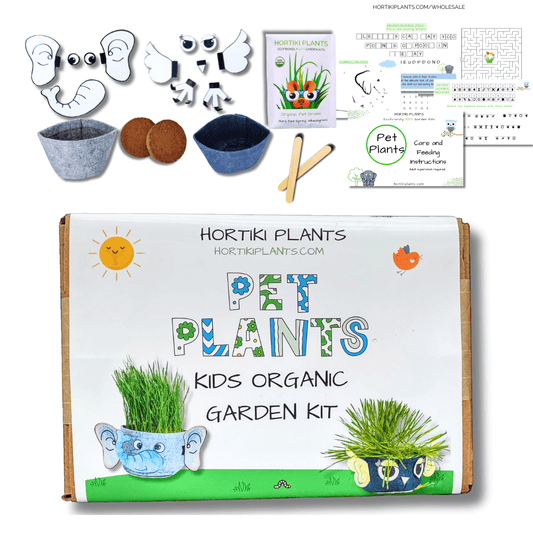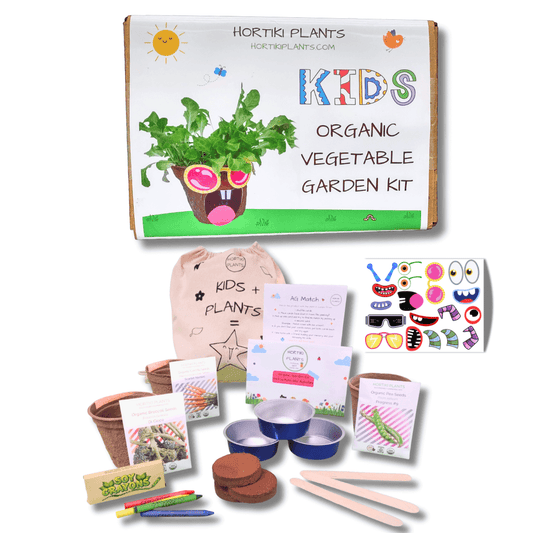Not-So Creepy Crawlers - Fun, STEAM Garden Activities for Halloween
Hortiki Plants
Not-so Creepy Crawlers - Fun, STEAM Garden Activities for Halloween
Halloween doesn’t have to be all about candy and costumes—this season is a perfect time to explore the essential, often-overlooked “not-so creepy crawlers” that make our gardens thrive! Bugs and insects are fascinating, educational, and vital for soil health, pollination, and composting.
This guide provides STEAM-aligned activities grouped by age (4–11), focusing on nature science, engineering, with reading suggestions to connect the hands-on fun with literacy!
Quick-Start Guide
Crucial Safety Tip
Please remind kids to be gentle observers—using their eyes and magnifying glass to watch the insects closely, but never harming their creepy crawler friends and leaving their habitats undisturbed.
💡 Tips for Educators (Curriculum & Logistics)
- Time Management: Break the longer projects (Bug Hotel) into two sessions: Research/Design (20 min) and Construction/Placement (30 min).
- Assessment Idea: Use the Bug Tracker (at the end) to assess observation skills. For older students, have them **graph the results** to connect math and science learning standards.
- Cross-Curricular Mapping: Use the Bug Bio descriptions to assess descriptive writing; use the Bug Hotel planning to assess practical engineering skills.
🏠 Tips for Families (Support & Differentiation)
- Sensory & Comfort Tip: If your child is bug-wary, start with the Ages 6–8 Craft first, using pictures or plastic bugs.
- Focus on "Doing": Instead of asking, "Did you find a bug?" try this **Parent/Caregiver Prompt:** "What's the most interesting thing you noticed a bug doing today?"
- Low-Cost Materials: Any sturdy container and simple yard scraps work perfectly for activities.
- Celebrate the Work: Create a small **"Science Corner"** to display the Bug Bios or the Bug Tracker.
Why Explore Garden Bugs?
Beneficial insects play key roles in keeping gardens healthy, tying directly into Science, Technology, Engineering, Art, and Math (STEAM) skills:
- Ladybugs: Tiny predators that eat thousands of aphids each year (Science: Predator/Prey).
- Worms: Decompose organic matter and enrich the soil (Technology/Engineering: Composting).
Introducing children to garden bugs fosters curiosity, observation, and respect for nature, building foundational skills for future scientific inquiry.
Activities by Age Group
Ages 4–6: Bug Discovery & Observation 🐛
Materials:
- Magnifying glass (optional)
- Notebook or “bug journal”
- Crayons or pencils
Instructions:
- Walk around your garden or yard and encourage children to look for insects.
- Let the kids draw what they see in their bug journals.
- Halloween Twist: Turn your hunt into a “Creepy Crawler Challenge”—award points for spotting, sketching, or identifying an insect that fits a theme.
STEAM Connection:
- Science: Observation skills and basic classification.
- Math: Basic counting (legs, spots).
- Art: Drawing and representational skills.
Reading Suggestions (ELA Tie-in): The Very Busy Spider by Eric Carle, In the Garden with Dr. Carver by Susan Grigsby.
Ages 6–8: Bug Crafts & Creative STEAM 🎨
Materials:
- Recycled cardboard, paper, or egg cartons
- Glue, tape, or string
- Crayons, markers, or paints
- Printable “Bug Bio” sheets (optional)
Instructions:
- Choose an insect to recreate. Research its anatomy (head, thorax, abdomen).
- Engineering Challenge: Build the bug using recycled materials (e.g., egg cartons for bodies, paper wings, pipe cleaner antennae).
- Fill out the short “Bug Bio” describing: name, habitat, diet, and garden role.
- Share creations with the group.
STEAM Connection:
- Engineering: Constructing 3D models from recycled materials.
- Art: Design, color theory, and fine motor skills.
- Science/ELA: Research and descriptive writing for the "Bug Bio."
Reading Suggestions (ELA Tie-in): The Grouchy Ladybug by Eric Carle, The Life Cycle of a Butterfly by Bobbie Kalman.
Ages 8–11: Build a Bug Hotel & Garden Investigation 🏨
Materials:
- Sturdy foundation (shoebox, plastic container, or crate)
- Twigs, pinecones, **hollow stems** (bamboo/sunflower stalks), straw, leaves
- Scissors or garden shears (adult supervision) and strong glue/duct tape
Instructions:
- Plan: Research simple bug hotel designs. Discuss which materials attract which bugs.
- Engineering Challenge: Fill the foundation with materials, packing them tightly for stability and weather resistance.
- Place & Observe: Place the finished hotel in a quiet, protected corner.
- Use the Bug Tracker: Observe the hotel over the following weeks and record new residents.
STEAM Connection:
- Engineering: Designing and building a stable, functional habitat (shelter).
- Science: Studying insect behavior and micro-ecology.
- Math: Calculating space and measuring materials (volume/area).
Reading Suggestions (ELA Tie-in): The Backyard Bug Book for Kids by Lauren Davidson, Roberto: The Insect Architect by Nina Laden.
Sample Bug Tracker
| Bug Name | Number Seen | Role in Garden | Fun Fact | Drawing |
|---|---|---|---|---|
Fun Fact: Ladybugs can eat up to 5,000 aphids in a single year—tiny heroes in every garden!
🎁 Take the Next Step: Extend the Learning!
You've explored observation, engineering, and art with the activities above. Ready to dive deeper into the world of garden science?
For additional experiments, hands-on planting activities, and everything you need to continue your insect education and create a flourishing habitat, check out Hortiki's STEM.org authenticated Garden Bugs Kids Garden Kit!

Teaching children about garden insects connects them to nature, builds observation and problem-solving skills, and fosters environmental stewardship. Halloween can be more than candy—it can be a season of discovery, creativity, and science!



